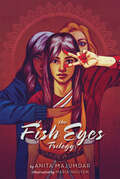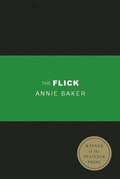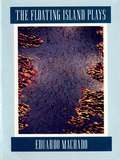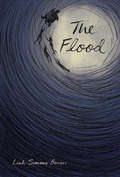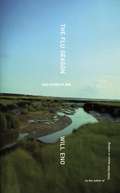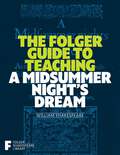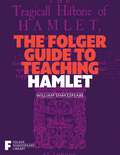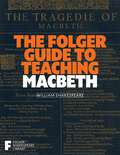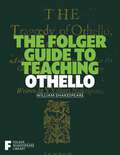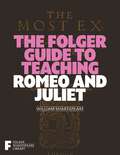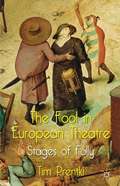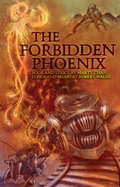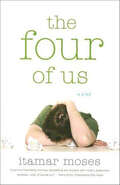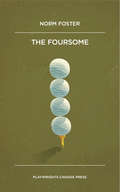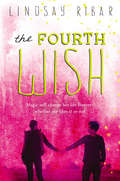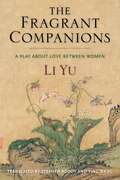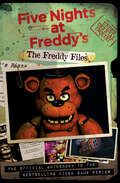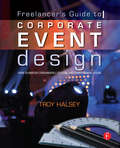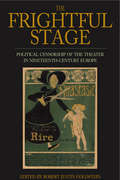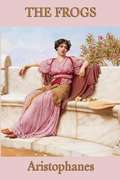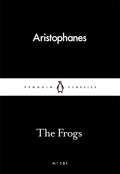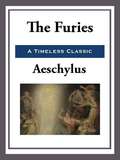- Table View
- List View
The Fish Eyes Trilogy
by Anita Majumdar Maria NguyenFish Eyes is the story of Meena, a classically trained Indian dancer who, despite being obsessed with Bollywood movies and her dance career, just wants to be like the rest of her high-school friends. When she develops a massive crush on Buddy, the popular boy at school, Meena contemplates turning down an incredible opportunity to pursue him, even if he barely notices her.Boys With Cars follows Naz, also a classically trained Indian dancer, who dreams of getting out of small town Port Moody to attend the University of British Columbia. But when Buddy causes a stir over Naz at school, Naz’s university plans begin to crumble quickly.Let Me Borrow That Top centres on Candice, a girl who appropriates Meena’s Indian dance skills and bullies Naz after a nasty rumour spreads through the halls of their high school. But like her two enemies, Candice shares a passion for Indian dancing, and has just been accepted to the Conventry School of Bhangra. Will she leave behind the comforts of home to pursue her dreams?
The Flick
by Annie Baker"Funny, heartbreaking, sly and unblinking...The Flick may be the best argument anyone has yet made for the continued necessity and profound uniqueness of theater." --Jesse Green, New York "Hilarious and ineffably touching...Ms. Baker's peerless aptitude for exploring how people grope their way toward a sense of equanimity, even as they learn to accept disappointment, is among the things that make her such a gifted writer...This lovingly observed play will sink deep into your consciousness." --Charles Isherwood, New York Times "This hypnotic, heartbreaking micro-epic about movies and moving on is irreducibly theatrical." --David Cote, TimeOut New York In a rundown movie theater in central Massachusetts, three underpaid employees sweep up popcorn in the empty aisles and tend to one of the last thirty-five-millimeter projectors in the state. With keen insight and a ceaseless attention to detail, The Flick pays tribute to the power of movies and paints a heartbreaking portrait of three characters and their working lives. A critical hit when it premiered Off-Broadway, this comedy, by one of the country's most produced and highly regarded young playwrights, was awarded the coveted 2013 Susan Smith Blackburn Prize, an Obie Award for Playwriting and the 2014 Pulitzer Prize for Drama. ANNIE BAKER'S works include The Aliens (Obie Award), Body Awareness, Circle Mirror Transformation (Obie Award), Nocturama, and an adaptation of Anton Chekhov's Uncle Vanya. Her work has been produced at more than a hundred theaters in the U.S. and in more than a dozen countries. Recent honors include a Guggenheim Fellowship, the Steinberg Playwright Award and a New York Drama Critics Circle Award. She is a resident playwright at Signature Theatre.
The Floating Island Plays
by Eduardo MachadoIncludes The Modern Ladies of Guanabacoa, Fabiola, In the Eye of the Hurricane and Broken Eggs.
The Flood: and other misadventures of the female prisoners of the St. Lawrence Market
by Leah Simone Bowen“I bore him fourteen children and he had me down here faster than lightning.” In 1887, women were property and could be imprisoned for any reason. Jail was considered a place for the criminal, the disabled, the mentally ill, and the marginalized. In the basement prison below Toronto’s largest market, two women named Mary—one a shunned, pregnant Irish immigrant, the other a vilified Mississauga woman—become an unlikely pair as they form a friendship within their cold, shared cell. Their bond threatens fellow inmate Sophia—who calls herself the first Black woman in Canada and the leader of the prisoners—and she plots to use the women to gain better treatment for herself. But as melting ice water pours into the prison from Lake Ontario, the forgotten women of Toronto must come together to survive. Inspired by true accounts and the history of Toronto’s St. Lawrence Market, The Flood gives voice to the little-known stories of early female prisoners in Canada.
The Flu Season and Other Plays
by Will Eno"Will Eno is one of the finest younger playwrights I have come across in a number of years. His work is inventive, disciplined and, at the same time, wild and evocative. His ear is splendid and his mind is agile."--Edward Albee "An original, a maverick wordsmith whose weird, wry dramas gurgle with the grim humor and pain of life. Eno specializes in the connections of the unconnected, the apologetic murmurings of the disengaged."--Guardian Winner of the 2004 Oppenheimer Award for best New York debut by an American playwright, The Flu Season is a reluctant love story, in spite of itself. Set in a hospital and a theater, it is a play that revels in ambivalence and derives a flailing energy from its doubts whether a love story is ever really a love story. Will Eno has been called "a Samuel Beckett for the Jon Stewart generation" (The New York Times)--he is a playwright with an extraordinary voice and a singular theatrical vision. Also included in this volume are Tragedy: A Tragedy and Intermission.
The Folger Guide to Teaching A Midsummer Night's Dream (Folger Shakespeare Library)
by Peggy O'BrienThe authoritative guide to teaching Shakespeare&’s A Midsummer Night&’s Dream, The Folger Guide to Teaching A Midsummer Night&’s Dream is an invaluable resource for teachers, students, and Shakespeare fans alike.In A Midsummer Night&’s Dream, Shakespeare stages the workings of love. Theseus and Hippolyta, about to marry, are figures from mythology. In the woods outside Theseus&’s Athens, two young men and two young women sort themselves out into couples—but not before they form first one love triangle, and then another. Also in the woods, the king and queen of fairyland, Oberon and Titania, battle over custody of an orphan boy; Oberon uses magic to make Titania fall in love with a weaver named Bottom, whose head is temporarily transformed into that of a donkey by a hobgoblin or &“puck,&” Robin Goodfellow. Finally, Bottom and his companions ineptly stage the tragedy of &“Pyramus and Thisbe.&” The Folger Guide to Teaching A Midsummer Night&’s Dream Includes: -An explanation of the Folger methodology for teaching Shakespeare -Scholarly essays from experts in the field -A five-week breakdown of digestible lesson plans -Resource links for a deeper dive into the world of Shakespeare This guide is an essential part of any teacher&’s toolkit.
The Folger Guide to Teaching Hamlet (Folger Shakespeare Library)
by Peggy O'BrienCreated by experts from the world&’s largest and most well-respected Shakespeare archive, The Folger Guide to Teaching Hamlet provides an innovative approach to teaching and understanding one of Shakespeare&’s most well-known plays.Hamlet follows the form of a revenge tragedy, in which the hero, Hamlet, seeks vengeance against the man he learns is his father&’s murderer—his uncle Claudius, now the king of Denmark. Much of its fascination, however, lies in its mysteries. Among them: Should Hamlet believe a ghost? What roles do Ophelia and her family play in Hamlet&’s attempts to know the truth? Was his mother, Gertrude, unfaithful to her husband or complicit in his murder, or both? How do the visiting actors cause the truth to begin to reveal itself? The Folger Guides to Teaching Shakespeare series is created by the experts at the Folger Shakespeare Library, the nation&’s largest archive of Shakespeare material and a leading center for both the latest scholarship and education on all things Shakespeare. Based on the proven Folger Method of teaching and informed by the wit, wisdom, and experiences of classroom teachers across the country, the guides offer a lively, interactive approach to teaching and learning Shakespeare, offering students and readers of all backgrounds and abilities a pathway to discovering the richness and diversity of Shakespeare&’s world. Filled with surprising facts about Shakespeare, insightful essays by scholars, and a day-by-day, five-week teaching plan, these guides are an invaluable resource for teachers, students, and Shakespeare fans alike.
The Folger Guide to Teaching Macbeth (Folger Shakespeare Library)
by Peggy O'BrienCreated by experts from the world&’s largest and most well-respected Shakespeare archive, The Folger Guide to Teaching Macbeth provides an innovative approach to teaching and understanding one of Shakespeare&’s most well-known plays.In 1603, James VI of Scotland ascended the English throne, becoming James I of England. London was alive with an interest in all things Scottish, and Shakespeare turned to Scottish history for material. The result was Macbeth, a bloody, supernatural tale of power found and lost, and of betrayal. The Folger Guides to Teaching Shakespeare series is created by the experts at the Folger Shakespeare Library, the nation&’s largest archive of Shakespeare material and a leading center for both the latest scholarship and education on all things Shakespeare. Based on the proven Folger Method of teaching and informed by the wit, wisdom, and experiences of classroom teachers across the country, the guides offer a lively, interactive approach to teaching and learning Shakespeare, offering students and readers of all backgrounds and abilities a pathway to discovering the richness and diversity of Shakespeare&’s world. Filled with surprising facts about Shakespeare, insightful essays by scholars, and a day-by-day, five-week teaching plan, these guides are an invaluable resource for teachers, students, and Shakespeare fans alike.
The Folger Guide to Teaching Othello (Folger Shakespeare Library)
by Peggy O'BrienThe authoritative guide to teaching Shakespeare&’s Othello, The Folger Guide to Teaching Othello is an invaluable resource for teachers, students, and Shakespeare fans alike.In Othello, William Shakespeare creates powerful drama from a marriage between the exotic Moor Othello and the Venetian lady Desdemona that begins with elopement and mutual devotion and ends with jealous rage and death. Shakespeare builds many differences into his hero and heroine, including race, age, and cultural background. Yet the couple&’s strong love would potentially easily overcome these differences were it not for Iago, who sets out to destroy Othello. Iago&’s false insinuations about Desdemona&’s infidelity draw Othello into his schemes, and Desdemona is subjected to Othello&’s horrifying verbal and physical assaults. The Folger Guide to Teaching Othello includes: -An explanation of the Folger methodology for teaching Shakespeare -Scholarly essays from experts in the field -A five-week breakdown of digestible lesson plans -Resource links for a deeper dive into the world of Shakespeare This guide is an essential part of any teacher&’s toolkit.
The Folger Guide to Teaching Romeo and Juliet (Folger Shakespeare Library)
by Peggy O'BrienCreated by experts from the world&’s largest and most well-respected Shakespeare archive, The Folger Guide to Teaching Romeo and Juliet provides an innovative approach to teaching and understanding one of Shakespeare&’s most well-known plays.Romeo and Juliet is one of Shakespeare&’s most well-known plays, and certainly the one most commonly taught in schools. It&’s the story of star-crossed young lovers who can&’t come together because they live in a society governed by blood feuds, violent duels and acts of retribution. Shakespeare&’s tale of Romeo and Juliet, the adults who fail to help them, and the price that is ultimately paid by so many is a moving story that gives us some of the most familiar and memorable passages in the English language. The Folger Guides to Teaching Shakespeare series is created by the experts at the Folger Shakespeare Library, the nation&’s largest archive of Shakespeare material and a leading center for both the latest scholarship and education on all things Shakespeare. Based on the proven Folger Method of teaching and informed by the wit, wisdom, and experiences of classroom teachers across the country, the guides offer a lively, interactive approach to teaching and learning Shakespeare, offering students and readers of all backgrounds and abilities a pathway to discovering the richness and diversity of Shakespeare&’s world. Filled with surprising facts about Shakespeare, insightful essays by scholars, and a day-by-day, five-week teaching plan, these guides are an invaluable resource for teachers, students, and Shakespeare fans alike.
The Fool in European Theatre
by Tim PrentkiWhy is folly essential to the functioning of a healthy society? Why is theatre a natural home for madness? The answers take the reader on a journey embracing Shakespeare and Jonson, Brecht and Beckett, B#65533;chner and Boal. From Falstaff to Fo via Figaro, this study examines the art of telling truth to power and surviving long enough to have a laugh.
The Forbidden Phoenix
by Marty Chan Robert Walsh Derek MahSun Wukong's path, however, becomes a test of strength, agility, and character as he comes face to face with mysterious, enchanting, and heartless creatures. Inspired by the Chinese opera, The Forbidden Phoenix's lyricism brings us to a world where Chinese parables are woven with the painful history of the immigrant men who suffered greatly to build Canada's railroad in the 1800s. Playwright Marty Chan and composer Robert Walsh create a musical rife with stylized characters, lending itself to a performance brimming with acrobatics, slapstick, and martial arts.
The Four of Us: A Play
by Itamar MosesFrom the author of Bach at Leipzig (Faber, 2005) comes a play about loyalty, integrity, and the price of success. When Benjamin's first novel vaults him into literary stardom, his friend David, a struggling playwright, is thrilled for his newfound success . . . or is he? Should Benjamin help David by using his new connections? Can David even expect such favors from his friend? More importantly, who should pick up the tab at lunch? Hailed as a writer who "makes the kinds of stylistic gambles that should be applauded" (Eric Grode, The New York Sun), Itamar Moses proves once again with this inventive exploration of the evershifting ground of friendship that he is a playwright to watch. The Four of Us had its off-Broadway premiere in March 2008 at Manhattan Theatre Club."Clever [and] smart…[The Four of Us] suggests that Moses will be displaying a big range as his career unfolds."--The San Diego Union-Tribune
The Foursome
by Norm FosterRick, Ted, Donnie, and Cameron are home for their fifteen-year college reunion; a great time to go out for a game of golf and catch up on each other’s lives. Unlike their college days, the conversation doesn’t include talk of beer and final exams, but of colonoscopies, home-security systems, alcoholism, Buddhism, and more.
The Fourth Wish
by Lindsay RibarHere's what Margo McKenna knows about genies: She's seen Aladdin more times than she can count; she's found a magic genie ring and made her three allotted wishes; she's even fallen head over heels in love with Oliver, the cute genie whose life she saved by fighting off another genie. But none of this prepared her for the shock of becoming a genie herself. Everything Margo's taken for granted--graduating high school, going to college, hating math, performing in the school musical, even being a girl--is in question. Just at a time when she's trying to figure out who she wants to be, Margo is forced to become whomever her master wants. But Margo is also coming into a power she never imagined she'd have. How will she reconcile the two? And where will she and Oliver stand when she's done? Fans of Every Day and Anna and the French Kiss will love this romantic, magical, and surprising conclusion to The Art of Wishing.
The Fragility of Goodness: Luck and Ethics in Greek Tragedy and Philosophy
by Martha C. NussbaumThis book is a study of ancient views about "moral luck. " It examines the fundamental ethical problem that many of the valued constituents of a well-lived life are vulnerable to factors outside a person's control, and asks how this affects our appraisal of persons and their lives. The Greeks made a profound contribution to these questions, yet neither the problems nor the Greek views of them have received the attention they deserve. This updated edition contains a new preface.
The Fragrant Companions: A Play About Love Between Women (Translations from the Asian Classics)
by Li YuTwo young gentry women meet by chance at a nunnery in Yangzhou, where they fall in love at first sight. After they exchange poetry and recognize each other’s literary talents, their emotional bond deepens. They conduct a mock wedding ceremony at the nunnery and hatch a plan to spend the rest of their lives together. Their schemes are stymied by a series of obstacles, but in the end the two women find an unlikely resolution—a ménage-à-trois marriage.The Fragrant Companions is the most significant work of literature that portrays female same-sex love in the entire premodern Chinese tradition. Written in 1651 by Li Yu, one of the most inventive and irreverent literary figures of seventeenth-century China, this play is at once an unconventional romantic comedy, a barbed satire, and a sympathetic portrayal of love between women. It offers a sensitive portrait of the two women’s passion for each other, depicts their intellectual pursuits and resourcefulness, and celebrates their partial triumph over social convention. At the same time, Li caustically mocks the imperial examination system and deflates the idealized image of the male scholar.The Fragrant Companions is both an indispensable source for students and scholars of gender and sexuality in premodern China and a compelling work of literature for all readers interested in China’s rich theatrical traditions.
The Freddy Files (Five Nights At Freddy's Ser.)
by Scholastic Scott CawthonDon't miss the first official guide to the world of the bestselling horror video game series, Five Nights at Freddy's, including easter eggs, gameplay tips, and the most hotly-debated fan theories.In the first official guidebook to Five Night at Freddy's, fans and gamers alike can immerse themselves in the series' mythology, gameplay, and secrets as we unwind the twisted mysteries hidden at the heart of Freddy Fazbear's Pizza. Delving into each game, players can map the animatronics' paths, learn how timed elements of the games work, and discover how to trigger unique events. Special sections throughout highlight Freddy's fans' most talked-about theories, from The Bite of '87 vs. The Bite of '83 to the identity of Purple Guy to the recurring hallucinations of "it's me." All the evidence, along with every detail of the games and novels, is laid out for fans to explore in this one-of-a-kind guide to the warped world of Five Nights at Freddy's.
The Freelancer's Guide to Corporate Event Design: From Technology Fundamentals To Scenic And Environmental Design
by Troy HalseyFreelancer's Guide to Corporate Theatre and Event Production (tentative title) will bring you up to speed on the ever changing and growing industry of Corporate Theatre. Written by one of the industry's leading designers, this book uses a candid and straight-forward style to guide you through the process of designing a successful event. Learn the fundamentals of venue selection, rigging, lighting, audio, video, and scenic design with informative diagrams and detailed illustrations. With the help of this book you will learn how to plan, design, and execute events of any size. Additionally, you will be armed with a strong knowledge of common mistakes, tips and tricks, and industry standards that will allow you to build and train a production team prepared for just about anything.
The French New Wave: A New Look (Shortcuts)
by Naomi GreeneThe French New Wave was perhaps the biggest —and briefest —explosion in the history of world cinema, with over one hundred French directors shooting debut features between 1958 and 1964. Its aftershocks are still being felt today. Through the work of such directors as Jean-Luc Godard and Franois Truffaut, filmmakers came to be seen as outstanding artists rather than mere studio technicians, paving the way for contemporary cinematic auteurs such as Martin Scorsese, Pedro Almodovar, and Luc Besson. This volume begins by tracing the social and cultural changes of post-war France that gave birth to the New Wave, then examines in detail the careers of artists like Alain Renais and Jean-Luc Godard. "The French New Wave: A New Look" is a concise and accessible account of a crucial movement in film history.
The Frightful Stage
by Robert Justin GoldsteinIn nineteenth-century Europe the ruling elites viewed the theater as a form of communication which had enormous importance. The theater provided the most significant form of mass entertainment and was the only arena aside from the church in which regular mass gatherings were possible. Therefore, drama censorship occupied a great deal of the ruling class's time and energy, with a particularly focus on proposed scripts that potentially threatened the existing political, legal, and social order. This volume provides the first comprehensive examination of nineteenth-century political theater censorship at a time, in the aftermath of the French Revolution, when the European population was becoming increasingly politically active.
The Frogs
by AristophanesVisiting the underworld, the god Dionysus seeks the counsel of the dead tragedians Aeschylus and Euripides on how to bring good writing back to Athens. A fierce debate - full of scathing insults and literary satire - ensues between the two dramatists.
The Frogs (Penguin Little Black Classics)
by Aristophanes'Ko-ax, ko-ax, ko-ax!Now listen, you musical twerps,I don't give a damn for your burps!'A biting comedy from the great Ancient Greek playwright.One of 46 new books in the bestselling Little Black Classics series, to celebrate the first ever Penguin Classic in 1946. Each book gives readers a taste of the Classics' huge range and diversity, with works from around the world and across the centuries - including fables, decadence, heartbreak, tall tales, satire, ghosts, battles and elephants.
The Furies
by AeschylusThis classic trilogy by the great tragedian deals with the bloody history of the House of Atreus. Grand in style, rich in diction and dramatic dialogue, the plays embody Aeschylus' concerns with the destiny and fate of both individuals and the state, all played out under the watchful eye of the gods.
